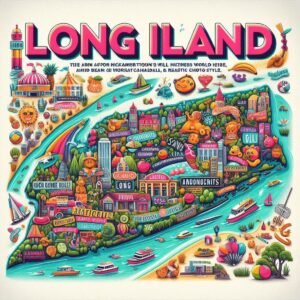Long Island, a geographic marvel stretching eastward from New York Harbor, is more than just a sprawling landmass adjacent to one of the world’s greatest cities. It is a region steeped in history, diverse in its landscapes, and vibrant in its culture, a place that has, over centuries, cultivated a rich tapestry of identities. This multifaceted character has naturally given rise to an array of nicknames, each reflecting a particular facet of its geography, its people, its economic life, or its social standing. From the simplest descriptor to the most evocative moniker, these nicknames are not mere casual labels; they are linguistic snapshots that encapsulate the essence of Long Island, revealing how it is perceived both by its inhabitants and by the wider world. To delve into these appellations is to embark on a fascinating journey through the island’s past and present, uncovering the stories, the stereotypes, and the deep-seated affections that define this unique corner of New York State. Understanding these nicknames provides a deeper appreciation for the complex identity of Long Island, moving beyond the simplistic notion of it merely being “New York’s backyard” to acknowledging it as a distinct entity with its own evolving narrative.

Nicknames for Long Island
2. The Geographic Gaze: Nicknames Rooted in Shape and Proximity
Many of Long Island’s most enduring nicknames derive directly from its physical form and its relationship to the mainland. These are the names that often first come to mind, grounded in readily observable facts.
“The Island”: Simplicity and Self-Assertion
Perhaps the most common and internally used nickname is simply “The Island.” This seemingly straightforward term carries a profound weight for its residents. It’s a declaration of distinctiveness, an assertion of an identity separate from the bustling metropolis of New York City, despite its close proximity. For those who live here, “The Island” isn’t just a geographic descriptor; it’s a tribal marker, signifying a shared experience and a unique way of life. It encapsulates the feeling of being removed, yet connected, a residential haven that still offers easy access to urban opportunities. This simple moniker reflects a collective consciousness, a shared understanding among its inhabitants that their home is a unique, self-contained world. It speaks to a sense of community and a subtle pride in their insular existence, where the bridges and tunnels that connect them to the city are often seen as entryways to another realm rather than essential links.
“The Fish”: A Cartographic Whimsy
Look at Long Island on a map, and its shape often evokes the image of a fish, particularly a large fluke or a whale, swimming eastward into the Atlantic. This playful, yet accurate, visual analogy has given rise to the nickname “The Fish.” The head would be the western end, encompassing Brooklyn and Queens (though often colloquially excluded from “Long Island” in the everyday sense), and the tail would be the iconic forks of the East End, stretching out towards Montauk Point. This nickname is popular in educational contexts and among those with a keen eye for geography, highlighting the island’s distinctive silhouette. It’s a whimsical yet practical way of visualizing the island’s form, making it easily recognizable and memorable, especially for those new to the region or studying its geography. The two “fins” of the tail — the North Fork and the South Fork — further enhance this piscine comparison, adding to its visual appeal and making it a memorable descriptor.
“The Backbone of New York”: A Foundation of Influence
While not as widely used as “The Island,” “The Backbone of New York” is a nickname that subtly acknowledges Long Island’s significant role in the broader New York metropolitan area. This term emphasizes its vital contributions, both economically and infrastructurally. Long Island serves as a massive residential base for commuters working in New York City, and its numerous industries, from aerospace to pharmaceuticals, contribute substantially to the state’s economy. Furthermore, it houses critical infrastructure, including major airports and transportation hubs. This nickname speaks to the idea that Long Island is an indispensable support system, a crucial pillar upon which much of New York’s functionality rests. It recognizes the quiet strength and stability that the island provides, often without the same level of media fanfare as its more famous urban neighbor. It underscores the profound interdependence between the island and the city, recognizing Long Island not just as a bedroom community but as a foundational element of the region’s prosperity and structure.
3. Cultural Currents and Social Stripes: Nicknames Reflecting Lifestyle and Identity
Beyond its physical attributes, Long Island’s nicknames are also deeply intertwined with its social fabric, economic history, and the evolving lifestyles of its inhabitants. These monikers often paint a vivid picture of the island’s cultural identity.
“Strong Island”: Grit, Resilience, and a Distinct Identity
“Strong Island” is a powerful and popular nickname, particularly among younger generations and those who identify with a more rugged, independent spirit. This moniker evokes a sense of resilience, grit, and a no-nonsense attitude often associated with Long Islanders. It suggests a community that is tough, self-reliant, and fiercely proud of its heritage, unafraid to stand up for itself. The term gained significant traction through hip-hop culture, further cementing its image as a place with a distinct and formidable character. It’s a nickname that speaks to a collective toughness forged by economic shifts, local challenges, and a desire to maintain a unique identity apart from the perceived softness of urban life. “Strong Island” is a badge of honor for many, signifying a community that values hard work, loyalty, and an undeniable sense of place. It also carries connotations of the island’s enduring appeal as a home for generations, suggesting a strong sense of roots and permanence that withstands external pressures.
(Image Suggestion: A graffiti-style mural with “Strong Island” prominently featured, or a photo of a community event showcasing local pride.)
“The Gold Coast”: Echoes of Opulence and Historical Grandeur
Stretching along the North Shore of Nassau County, “The Gold Coast” is a nickname rooted in the early 20th century, a period when industrialists and financiers built opulent mansions and estates, transforming the landscape into a playground for the incredibly wealthy. This era, immortalized in F. Scott Fitzgerald’s The Great Gatsby, left an indelible mark on the region’s reputation. Even today, the term “The Gold Coast” conjures images of grand estates, exclusive clubs, and a legacy of old money and aristocratic splendor. While many of the original estates have been subdivided or converted into institutions, the nickname persists, serving as a reminder of a bygone era of immense wealth and lavish living. It speaks to a specific geographic and historical segment of Long Island, one that continues to influence its perception as a place of affluence and historical significance. The architectural grandeur that remains, even in a diminished capacity, continues to lend credence to this gilded moniker.
“The Suburbs”: A Label of Residential Evolution
For many outside the region, Long Island is simply synonymous with “The Suburbs.” This nickname reflects its predominant character as a vast residential expanse serving the greater New York metropolitan area. Following World War II, Long Island experienced an explosive population boom, largely driven by the development of planned communities like Levittown. This era established its identity as the quintessential American suburb, characterized by single-family homes, manicured lawns, and a car-dependent lifestyle. While Long Island is far more diverse than this single label suggests, “The Suburbs” remains a widely recognized and often defining characteristic. It speaks to the island’s role as a haven for families seeking a quieter life outside the city, a place where the American dream of homeownership took root and flourished on a massive scale. This nickname, while perhaps less evocative, is a factual representation of how millions have come to call Long Island home.
“Lawn Guy Land”: A Playful Nod to its Horticultural Obsession
A more recent and humorous nickname, “Lawn Guy Land,” plays on the phonetic similarity of “Long Island” and highlights a pervasive cultural characteristic: the fervent dedication of many residents to their lawns. This jocular term pokes fun at the meticulous care, significant investment, and sometimes competitive spirit involved in maintaining pristine suburban landscapes. From perfectly manicured hedges to vibrant flowerbeds, the pursuit of the ideal lawn is a quintessential Long Island pastime. “Lawn Guy Land” is a lighthearted nod to this cultural phenomenon, instantly recognizable to anyone who has spent time in the region. It points to a particular brand of suburban pride and the unique aesthetics that define many of Long Island’s residential neighborhoods, adding a touch of humor to its identity.
4. The East End Ensemble: Nicknames of Hamptons and Beyond
The easternmost reaches of Long Island, particularly the two forks, have developed their own distinct set of nicknames, reflecting their unique character and their status as premier vacation destinations.
“The Hamptons”: Synonymous with Summer Splendor
Undoubtedly the most famous of Long Island’s regional nicknames, “The Hamptons” refers collectively to a group of exclusive villages and hamlets on the South Fork of Suffolk County. This name conjures images of celebrity, luxury, pristine beaches, and a vibrant summer social scene. It is a globally recognized brand, synonymous with wealth, leisure, and upscale living. The Hamptons, as a nickname, transcends its geographic boundaries, representing a lifestyle that is aspirational for many and a reality for a select few. It speaks to the island’s capacity to host and cater to an elite clientele, transforming a once agricultural region into a world-renowned resort destination. The power of “The Hamptons” as a nickname is undeniable, shaping perceptions of not just the East End but of Long Island as a whole.
“The End”: A Geographic and Psychological Boundary
“The End” is a simple, yet evocative nickname for the very easternmost tip of Long Island, particularly Montauk. It signifies not just a geographic terminus but also a psychological boundary. For many, reaching “The End” feels like arriving at the edge of the world, a place of wild beauty, rugged coastlines, and a sense of remote tranquility. It’s a place where the land gives way to the vast expanse of the Atlantic Ocean, offering a distinct contrast to the bustling western parts of the island. This nickname captures the spirit of Montauk as a retreat, a place where one can truly escape and feel disconnected from the daily grind, embodying a sense of finality and dramatic beauty.
“Potato Land”: A Vestige of Agricultural Heritage
Before the rise of suburbanization and the glamour of the Hamptons, much of Long Island, particularly the East End, was dominated by agriculture, with potatoes being a significant crop. “Potato Land” is a historical nickname that harks back to this rich farming heritage. While much of the farmland has given way to development, this nickname serves as a reminder of the island’s roots as a productive agricultural region. It speaks to a simpler time, a different economy, and a legacy that still subtly influences the landscape and character of certain areas. Though less prevalent today, it remains a charming historical reference that grounds Long Island in its agrarian past.
5. Evolution and Endearment: How Nicknames Shape Perception
The array of nicknames for Long Island is not merely a collection of labels; it is a dynamic testament to its evolving identity and how it is perceived both internally and externally. These monikers are powerful tools, shaping narratives and influencing public consciousness.
The Power of Local Lexicon
Within the communities of Long Island, these nicknames form part of a shared lexicon, a shorthand that communicates a wealth of information and cultural understanding. “The Island” fosters a sense of collective identity, while “Strong Island” reinforces local pride and resilience. These terms are used in everyday conversation, in local media, and even in artistic expressions, building a strong sense of regional belonging. They are more than just words; they are symbols that unite residents and differentiate them from those “off the Island.” The internal use of these nicknames strengthens community bonds and reflects a deep-seated connection to the land and its unique way of life.
Marketing, Tourism, and the Cultivation of an Image
Beyond local use, nicknames also play a crucial role in marketing and tourism. “The Hamptons,” for instance, is a marketing juggernaut, instantly conveying an image of luxury and exclusivity that attracts visitors and investment. The perception of Long Island as “The Suburbs” influences real estate markets and lifestyle branding. Even “The Fish” can be used in educational or promotional materials to visually identify the region. These nicknames, whether intentionally or organically, help to cultivate and reinforce certain images of Long Island to a broader audience, influencing tourism, economic development, and even political perceptions. They are effective in communicating the island’s diverse offerings and unique selling points to potential visitors and new residents alike.
6. A Tapestry of Titles: A Summary of Long Island Nicknames
7. Conclusion: More Than Just a Place, It’s a Persona
Long Island, far from being a monolithic entity, is a place of multifaceted identity, wonderfully encapsulated by its diverse array of nicknames. From the proud assertion of “The Island” to the opulent echoes of “The Gold Coast,” and the resilient spirit of “Strong Island,” each moniker offers a unique lens through which to view this vibrant region. These names are not merely labels; they are narratives, etched into the collective consciousness, reflecting its history, culture, and enduring allure. Ultimately, these nicknames paint a compelling portrait of Long Island as a dynamic and deeply cherished home.
8. Frequently Asked Questions (FAQs)
Q1: Why is Long Island called “The Island” if it’s connected to New York City? A1: While technically connected by bridges and tunnels, “The Island” is a self-designation by residents that emphasizes their distinct cultural identity, lifestyle, and sense of community, separate from the urban bustle of New York City. It signifies a shared regional pride.
Q2: What is the origin of the nickname “Strong Island”? A2: “Strong Island” emerged from local pride and urban culture, particularly gaining traction within the hip-hop community. It signifies a sense of resilience, grit, and a no-nonsense attitude often associated with Long Islanders.
Q3: Does “The Hamptons” refer to all of Long Island? A3: No, “The Hamptons” specifically refers to a group of affluent villages and hamlets located on the South Fork of Suffolk County, in the eastern part of Long Island. It is a high-profile part of Long Island, but not representative of the entire geographic area.
Q4: Is Long Island still “Potato Land”? A4: While much of Long Island’s farmland has been developed, especially in the western parts, “Potato Land” is a historical nickname that reflects its significant agricultural past, particularly on the East End. Some farming still exists, but it’s not the dominant industry it once was.
Q5: Are these nicknames used by people outside of Long Island? A5: Some nicknames, like “The Hamptons” and “The Suburbs,” are widely recognized internationally. Others, like “The Island” and “Strong Island,” are more prevalent among residents and those closely familiar with the region, serving as internal markers of identity.






